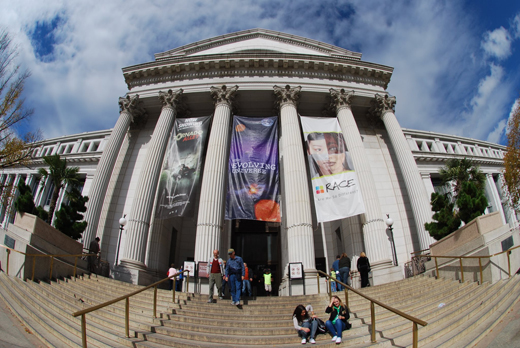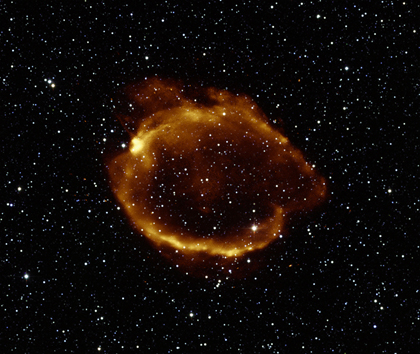Submitted by chandra on Thu, 2011-10-27 13:26
Submitted by chandra on Thu, 2011-10-27 12:25

This image combines data from four different space telescopes to create a multi-wavelength view of all that remains of the oldest documented example of a supernova, called RCW 86. The Chinese witnessed the event in 185 A.D., documenting a mysterious "guest star" that remained in the sky for eight months. X-ray images from NASA's Chandra X-ray Observatory and the European Space Agency's XMM-Newton Observatory are combined to form the blue and green colors in the image. The X-rays show the interstellar gas that has been heated to millions of degrees by the passage of the shock wave from the supernova.
Submitted by chandra on Wed, 2011-10-26 10:52
 Credit: Jonathan McDowell, SAO
Credit: Jonathan McDowell, SAOThis week, a new exhibit opened at the Smithsonian's National Museum of Natural History in Washington, DC. The "Evolving Universe" exhibit showcases many images from Chandra along with other telescopes and projects that involve the Smithsonian Astrophysical Observatory (SAO). This project, which can be found on the second floor of the museum, is a collaboration between these two branches of the Smithsonian, and gives visitors a chance to learn a little bit more about what happens at SAO's Cambridge, MA location. The exhibit will be on display now through January 20, 2012, so don't miss it.
Submitted by chandra on Tue, 2011-10-25 12:52

Astronomers have used a large survey to test a prediction that close encounters between galaxies can trigger the rapid growth of supermassive black holes. Key to this work was Chandra's unique ability to pinpoint actively growing black holes through the X-rays they generate.
The researchers looked at 562 pairs of galaxies ranging in distances from about 3 billion to 8 billion light years from Earth. They found that the galaxies in the early stages of an encounter with another were more likely than isolated, or "lonelier" galaxies to have actively growing black holes in their cores.
Submitted by chandra on Mon, 2011-10-24 11:26
October is American Archives Month—a time to celebrate the importance of archives across the country. In honor of Archives Month, we're participating in a pan-Smithsonian blogathon. Throughout October we, and other blogs from across the Smithsonian, will be blogging about Chandra's rich archive of astronomical data, issues, and behind-the-scenes projects.
----------------------------------------------------------------------------------------------------------------------------------------------------------
Concluding our series of Archives Month blog posts, we thought we'd shift our focus towards the future of Chandra's digital legacy. Although the modern marvel of engineering that is the Chandra X-ray Observatory will not last forever, its lasting gift to humanity will be its archive of data. Long after the last bits of X-ray light have found their way to Chandra's detectors, scientists and curious amateurs will still be pouring over Chandra's archival data looking for their particular X-ray needle in the digital haystack.
Submitted by chandra on Thu, 2011-10-20 10:39
Aneta Siemiginowska is an astrophysicist at the Chandra X-ray Center. In addition to her responsibilities for Chandra’s Science Data System group, she is actively involved is exploring the Universe, particularly its black holes and galaxies.
For as long as I can remember, I wanted to learn about stars. The winter sky displayed the entire Universe right in front of me and I wanted to learn and understand the sky and the space. I do not think I understood what it meant to become an astronomer when I was a six year old, but each time somebody asked me what do I want to be when I grew up I answered, "I want to be an astronomer".
Submitted by chandra on Mon, 2011-10-17 10:58
October is American Archives Month—a time to celebrate the importance of archives across the country. In honor of Archives Month, we're participating in a pan-Smithsonian blogathon. Throughout October we, and other blogs from across the Smithsonian, will be blogging about Chandra's rich archive of astronomical data, issues, and behind-the-scenes projects.
----------------------------------------------------------------------------------------------------------------------------------------------------------
This past summer, I interned in the Chandra Education and Public Outreach department at the Smithsonian Astrophysical Observatory (SAO), where I spent several months sleuthing around the Chandra data archives as part of an on-going Astronomy Visualization Metadata (AVM) tagging project http://www.virtualastronomy.org/. AVM is data embedded into each image of astronomical objects that includes information such as the objects coordinates, the instrument and instrument settings used for capturing the image, and a description of the image. The goal of the project is to tag all the press release images from the Chandra X-ray telescope with metadata.
Submitted by chandra on Wed, 2011-10-12 08:52

G299.2-2.9 is an intriguing supernova remnant found about 16,000 light years away in the Milky Way galaxy . Evidence points to G299.2-2.9 being the remains of a Type Ia supernova, where a white dwarf has grown sufficiently massive to cause a thermonuclear explosion. Because it is older than most supernova remnants caused by these explosions, at an age of about 4500 years, G299.2-2.9 provides astronomers with an excellent opportunity to study how these objects evolve over time. It also provides a probe of the Type Ia supernova explosion that produced this structure.
Submitted by chandra on Tue, 2011-10-11 11:11
October is American Archives Month—a time to celebrate the importance of archives across the country. In honor of Archives Month, we're participating in a pan-Smithsonian blogathon. Throughout October we, and other blogs from across the Smithsonian, will be blogging about Chandra's rich archive of astronomical data, issues, and behind-the-scenes projects.
----------------------------------------------------------------------------------------------------------------------------
Submitted by chandra on Mon, 2011-10-10 09:57
This week, the latest incarnation of the Communicating Astronomy with the Public (CAP) series of meetings is happening in Beijing, China. There have been several of these meetings around the world – Munich in 2005, Athens in 2007, and Cape Town in 2010. Each of these, with a slightly different twist, have been designed to bring those of us who do astronomy outreach and communication together to discuss best practices, new ideas, emerging trends, etc.
This week, the focus will be to look at the ever-evolving landscape of modern communication and how astronomy can – and should – fit in. We are here talking about some of the latest work we’ve done in what we call “public science”. Like public art, public science strives to engage people in their everyday lives. Instead of having the general public stumble across a piece of artwork, we suggest that unintentionally interacting with science could be surprising, inspiring, and beneficial to any efforts to boost scientific interest and literacy.
And, most importantly, we are here to see old and new colleagues and to learn what else is going on around the world in astronomy communication. It’s great for CAP to be in Asia for the first time, and we are looking forward to an exciting week.
-Megan Watzke, Kim Arcand et al.
Pages